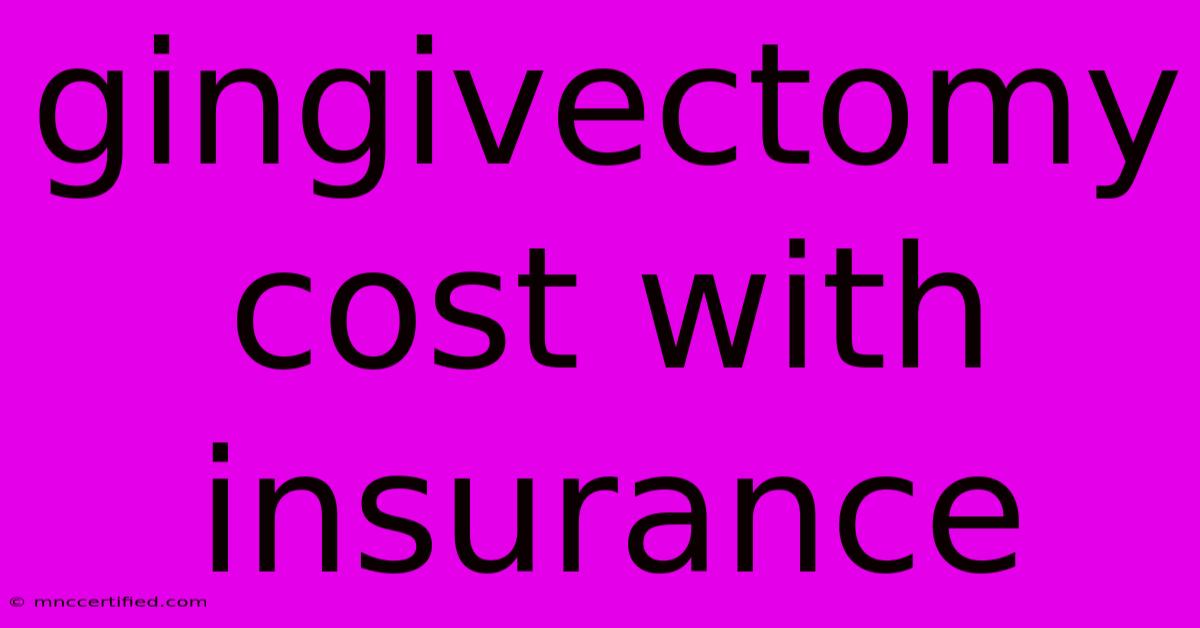Gingivectomy Cost With Insurance

Table of Contents
Gingivectomy Cost with Insurance: A Comprehensive Guide
Planning for a gingivectomy? Understanding the costs involved is crucial. This comprehensive guide breaks down the average gingivectomy cost, how insurance impacts the final price, and factors influencing the overall expense. We'll also cover ways to minimize your out-of-pocket expenses.
What is a Gingivectomy?
A gingivectomy is a surgical procedure performed by a periodontist (gum specialist) or dentist to remove excess gum tissue. This is often necessary to treat gum disease (gingivitis or periodontitis), expose more of the tooth structure for restorative procedures like crowns or bridges, or improve the overall aesthetics of your smile. The procedure typically involves using a scalpel, laser, or electrosurgery to precisely remove the affected gum tissue.
Average Gingivectomy Cost Without Insurance
The cost of a gingivectomy without insurance can vary significantly depending on several factors:
- Geographic location: Costs in major metropolitan areas tend to be higher than in smaller towns.
- Dentist's experience and expertise: Specialists and highly experienced dentists may charge more.
- Complexity of the procedure: Extensive gum tissue removal or additional procedures will increase the cost.
- Anesthesia: The type of anesthesia used (local, sedation, or general) affects the overall price.
- Additional procedures: If the gingivectomy is combined with other procedures, such as bone grafting or scaling and root planing, the total cost will rise.
On average, a gingivectomy can cost anywhere from $500 to $2,000 or more per quadrant without insurance coverage.
How Insurance Affects Gingivectomy Costs
Most dental insurance plans cover at least a portion of the gingivectomy cost, but the extent of coverage depends on several factors:
- Your specific insurance plan: Check your policy's details carefully. Some plans have annual maximums, while others may only cover a percentage of the procedure. Look for terms like "periodontal coverage" or "gum disease treatment."
- Pre-existing conditions: If you have pre-existing gum disease, your coverage might be affected. Some plans may require a waiting period before covering periodontal procedures.
- Preventive vs. restorative: Insurance often covers preventative care (like cleanings) more generously than restorative procedures (like gingivectomy). Your plan might consider a gingivectomy necessary to prevent further gum disease, thus enhancing coverage.
- Necessary vs. cosmetic: If the gingivectomy is purely for cosmetic reasons, coverage is less likely. However, if it's medically necessary to treat gum disease or improve oral health, the chances of coverage are much higher.
Before scheduling your procedure, contact your insurance provider directly to confirm your coverage for gingivectomy and obtain a pre-authorization if needed. This will help you estimate your out-of-pocket expenses.
Minimizing Gingivectomy Costs
Here are some ways to reduce your out-of-pocket costs:
- Negotiate with your dentist: Discuss payment plans or discounts.
- Explore financing options: Dental financing companies offer payment plans to help manage the cost.
- Choose a dentist in your network: If you have dental insurance, opting for an in-network provider will generally result in lower costs.
- Maintain good oral hygiene: Regular brushing, flossing, and dental check-ups can help prevent gum disease and reduce the need for a gingivectomy.
Frequently Asked Questions (FAQs)
Q: Does Medicaid cover gingivectomy? A: Medicaid coverage varies by state, but it often covers medically necessary gingivectomies. Contact your state's Medicaid office for specifics.
Q: Does Medicare cover gingivectomy? A: Medicare generally doesn't cover routine dental care, including gingivectomies. However, there may be limited coverage under certain circumstances if the procedure is deemed medically necessary due to a related medical condition.
Q: How long does it take to recover from a gingivectomy? A: Recovery time varies but typically involves some discomfort and swelling for a few days. Follow your dentist's post-operative instructions carefully.
This guide provides general information. Always consult with your dentist or periodontist to discuss your specific situation, get an accurate cost estimate, and understand your insurance coverage before undergoing a gingivectomy. Remember, maintaining good oral hygiene is key to preventing gum disease and the need for extensive procedures like gingivectomies.

Thank you for visiting our website wich cover about Gingivectomy Cost With Insurance. We hope the information provided has been useful to you. Feel free to contact us if you have any questions or need further assistance. See you next time and dont miss to bookmark.
Featured Posts
-
Penn Dot District 10 Winter Driving Safety
Nov 21, 2024
-
Property Insurance Claim Lawyers
Nov 21, 2024
-
New Caney Insurance New Caney Tx
Nov 21, 2024
-
Iceland Volcano 10th Eruption Video
Nov 21, 2024
-
Morrissey Free Speech Music Blocked
Nov 21, 2024